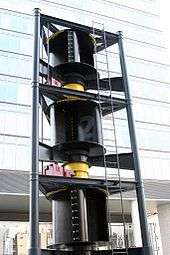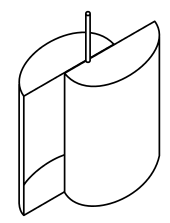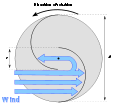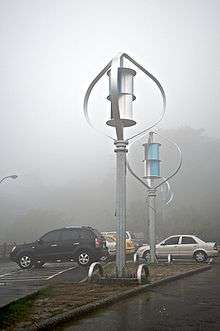Savonius wind turbine

Savonius wind turbines are a type of vertical-axis wind turbine (VAWT), used for converting the force of the wind into torque on a rotating shaft. The turbine consists of a number of aerofoils, usually—but not always—vertically mounted on a rotating shaft or framework, either ground stationed or tethered in airborne systems.
Origin
The Savonius wind turbine was invented by the Finnish engineer Sigurd Johannes Savonius in 1922. However, Europeans had been experimenting with curved blades on vertical wind turbines for many decades before this. The earliest mention is by the Italian Bishop of Czanad, Fausto Veranzio, who was also an engineer. He wrote in his 1616 book Machinae novae about several vertical axis wind turbines with curved or V-shaped blades. None of his or any other earlier examples reached the state of development made by Savonius. In his Finnish biography there is mention of his intention to develop a turbine-type similar to the Flettner-type, but autorotationary. He experimented with his rotor on small rowing vessels on lakes in his country. No results of his particular investigations are known, but the Magnus effect is confirmed by König.[1] The two Savonius patents: US1697574, were filed in 1925 by Sigurd Johannes Savonius, and US1766765, in 1928.
Operation

The Savonius turbine is one of the simplest turbines. Aerodynamically, it is a drag-type device, consisting of two or three scoops. Looking down on the rotor from above, a two-scoop machine would look like an "S" shape in cross section. Because of the curvature, the scoops experience less drag when moving against the wind than when moving with the wind. The differential drag causes the Savonius turbine to spin. Because they are drag-type devices, Savonius turbines extract much less of the wind's power than other similarly-sized lift-type turbines. Much of the swept area of a Savonius rotor may be near the ground, if it has a small mount without an extended post, making the overall energy extraction less effective due to the lower wind speeds found at lower heights.
Power and rotational speed
According to Betz's law, the maximum power that is possible to extract from a rotor is , where is the density of air, and are the height and radius of the rotor and is the wind speed. However, in practice the extractable power is about half that [2] (one can argue that only one half of the rotor — the scoop co-moving with the wind — works at each instant of time). Thus, one gets .
The angular frequency of a rotor is given by , where is a dimensionless factor called the tip-speed ratio. λ is a characteristic of each specific windmill, and for a Savonius rotor λ is typically around unity.
For example, an oil-barrel sized Savonius rotor with h=1 m and r=0.5 m under a wind of v=10 m/s, will generate a maximum power of 180 W and an angular speed of 20 rad/s (190 revolutions per minute).
Use
Savonius turbines are used whenever cost or reliability is much more important than efficiency.
Most anemometers are Savonius turbines for this reason, as efficiency is irrelevant to the application of measuring wind speed. Much larger Savonius turbines have been used to generate electric power on deep-water buoys, which need small amounts of power and get very little maintenance. Design is simplified because, unlike with horizontal axis wind turbines (HAWTs), no pointing mechanism is required to allow for shifting wind direction and the turbine is self-starting. Savonius and other vertical-axis machines are good at pumping water and other high torque, low rpm applications and are not usually connected to electric power grids. In the early 1980s Risto Joutsiniemi developed a helical rotor (wiki:fi) version that does not require end plates, has a smoother torque profile and is self-starting in the same way a crossed pair of straight rotors is.
The most ubiquitous application of the Savonius wind turbine is the Flettner rotor, which is commonly seen on the roofs of vans and buses and is used as a cooling device. The ventilator was developed by the German aircraft engineer Anton Flettner in the 1920s. It uses the Savonius wind turbine to drive an extractor fan. The vents are still manufactured in the UK by Flettner Ventilator Limited.[3]
Small Savonius wind turbines are sometimes seen used as advertising signs where the rotation helps to draw attention to the item advertised. They sometimes feature a simple two-frame animation.
Tethered airborne Savonius turbines
- Airborne wind turbines
- Kite types
- When the Savonius rotor axis is set horizontally and tethered, then kiting results. There are scores of patents and products that use the net lift Magnus effect that occurs in the autorotation of the Savonius rotor. The spin may be mined for some of its energy for making noise, heat, or electricity.
Gallery
 Operation of a Savonius turbine
Operation of a Savonius turbine- A Savonius rotor bladed WECS
References
- ↑ Felix van König (1978). Windenergie in praktischer Nutzung. Pfriemer. ISBN 3-7906-0077-6.
- ↑ "Increase in the Savonius rotors efficiency via a parametric investigation". ResearchGate. Retrieved 2017-06-02.
- ↑ Flettner
External links
| Wikimedia Commons has media related to Savonius wind turbines. |
